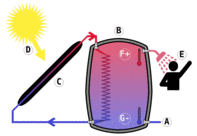 |
You are here: Home > Energy resources > Sources & resources > Renewable energy > Micro generation > Embodied energy
|
|
Energy paybackIf you add microgeneration, or any energy saving systems to your house, they will have to be working for some time before they have paid back the energy used in their manufacture. Until they have done so, they’re not really saving any energy at all. So to find out if microgeneration is worth it in any given location, the person doing the planning must find out the embodied energy any proposed system and compare this to what it will actually generate in that location. An inappropriately chosen system may never recoup the energy used to build it.
|



 Benefits of assessing embodied energy in buildings
Benefits of assessing embodied energy in buildings Is it worth it?
Is it worth it?
What's your opinion?
Average rating




Not yet rated